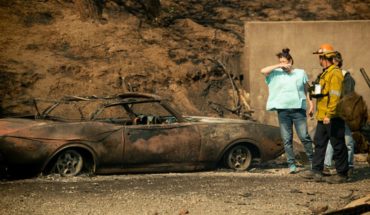The second week of October 2019 announced the expected double submission of the Nobel Prize in Literature. Two were elected due to the previous year’s suspension. One of the winners turned out to be Polish writer Olga Tokarczuk. Coincidentally, anagrama was preparing the Spanish edition of his novel Los Errantes.
The book, original lynative in 2007, had previously been translated into English, earning recognitions and awards such as the Man Booker International. Possessing a sufficient work and recognized in her native Poland, we, in the Spanish-speaking world, had no major references about Olga Tokarczuk.
In a first and shallow glance you can conclude being at the head of a novel of fragmentary style. It consists of sections of various lengths, where some of them do not reach exceeding half a page. We also find that images are interspersed every now and then. In this case illustrations from different eras. Maps and plans of cities, gardens, oceans and rivers of the world. Are we looking at something new?
Lol This kind of experimentation in forms exists. And a distrust bias is automatically triggered against these exercises. The reader’s defense seeks not to be deceived by the forced mirage of the experimental, the use of images and the excess of fragmentation in disarray of the creative and stylistic difficulties that signify the continuity of a well-forged story. Stories that they can’t synthesize on the back cover either. So we don’t know what this is about.
“Here I Am” is the title that bears the first chapter. The memory of the day when the little girl is left alone at home where the burden caused by stillness stands out. “The most annoying thing is the stillness: thick, visible.” Then at the beginning of the second chapter, the protagonist recalls her first journey. A lonely walk, hiding from his family, towards the Odra River. “As I faced the containment embankment, I could see an oscillating tape, a path that medered beyond the frame. Of the world”. As opposed to the overwhelming initial stillness, the protagonist experiences for the first time the energy generated by the “movement”. And it is in this word that one of the themes of the book begins to be discerned.
These first pages, vivid childhood imaginings in Poland in the late 1960s, are of ensourhing beauty. In the face of this, the reader’s hesitations are gathered and we let the narrator: an unnamed Polish writer begin to unfold her cabinet of curiosities. Always on the move. It deploys them through memories, conversations, encounters in different places; such as planes, buses, trains, ferries, hotels and airports. We realize, as we tour with it strange museums where biological anomalies and human organisms preserved in formaldehyde are exhibited, that the mortality of the body is another of the central contents of the novel.
This exploratory energy, where fiction coexists with nonfiction, is nuanced by an acute, intelligent and cultured observer.
There are stories based on real events such as those of Philip Verheyen, the 17th-century anatomist, who writes letters to his amputated leg. The one in Chopin’s heart, secretly transported into a bottle of alcohol between his sister Ludwika’s petticoats for a second burial in Poland. Joséphine Soliman’s letters addressed to Francis I of Austria, requesting the return of his father’s body, dissected and displayed in his Imperial Majesty’s Natural Curiosities cabinet.
There are small exercises of theory and observation. For example: about finding the point where time and space reach an agreement.
And to find that right time and place it is necessary to be on the move: “There you can find great love, happiness, a tenth prize of the lottery or the explanation of a great mystery that everyone has been searching for years in vain, or death.” He theorizes why night trains with a sleeper car are trains for cowards. About how annoying it is to meet compatriots in faraway places. A series of ingenious, erudite and at the same time entertaining digressions of this voice that is already made reliable to us. The one that tells us the story of the first travel guide, written in Poland in the early eighteenth century by a Catholic priest who never left his hometown, and then confessed that his second guide is Moby Dick, a book with which he relates in his encyclopedism.
There are also the fiction stories, of greater length, and where the talent that the pen of the writer can achieve is best appreciated.
Kunicki, a Polish man, searches for his mysteriously missing wife and children on an island in Croatia. Dr. Blau’s trips to congresses dedicated to the conservation of medical specimens, mainly the plastination of human tissues. The story of Innushka, a Russian woman who dives into the Moscow metro network escaping her sick son, her husband, from the static life in the suburbs.
In “Zone of God,” a Polish biologist returns to Warsaw to help an agonizing love of youth. In Kairos, a retired professor, expert in everything that has been written, excavated and said of Greece. Lecture passengers on an elegant cruise ship that travel through the country’s islands. The wife of the professor scrutinized the hearing public and repaired the way the young people follow the speaker in concentrated silence, and ponders on these new generations: “Behold a new kind of intellect, karen thought, who does not trust the word printed in books , in the best manuals, articles, monographs and encyclopedias, intellect battered during the university career and which now has hiccups……. Rational and discursive, solitary and sterile intellect. But it moves fast, a brilliant, intelligent, unrestricted electronic impulse, relating everything to everything, convinced that everything together means something, we just don’t know what.”
At the end of this unclassifiable novel I have not yet to sum up, we have no doubt that Olga Tokarczuk is a European humanist with all her lyrics. Soaked in the tradition of thinker, novelist, essayist, he manages with naturalness and art to combine fiction, cultural anthropology and memory. He clearly knows what he’s doing. And in the end the thread that joins each of these fragments that initially seemed scattered to us are the usual questions. Those who face good art: the world in motion, the mortality of the body, the meaning of home and belonging. It’s a job that beats fashion or rather combines it with the old. A genuine desire to portray the world.
The Wanderers. Editorial Anagram. 386 pages.
translated from Spanish: “The Wanderers”. The Fragmentary Novel by Olga Tokarczuk
January 21, 2020 |





